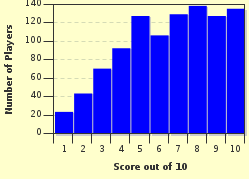Quiz Answer Key and Fun Facts
1. What is a sphygmomanometer?
2. Which of the following pulse sites is located behind the knee?
3. What would a temperature reading of 38.2 degrees Celsius be in Fahrenheit?
4. For a BP reading of 140/92, what is the bottom number (92) known as?
5. When a blood pressure reading is taken, a sequence of different sounds is heard. What are these called?
6. What is the medical term for "fever"?
7. What heart action causes the lub-dub sounds that are heard over the heart with a stethoscope?
8. Which vital sign is most susceptible to conscious control?
9. What is the term that describes the absence of breathing?
10. Where is the apical pulse located in an adult client?
Source: Author
saturnwreck
This quiz was reviewed by FunTrivia editor
crisw before going online.
Any errors found in FunTrivia content are routinely corrected through our feedback system.


